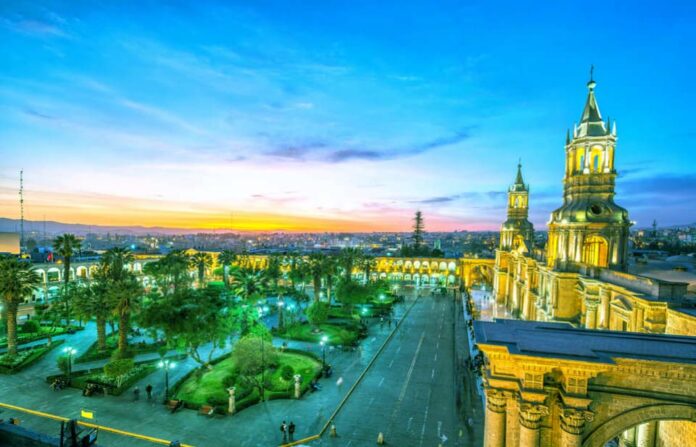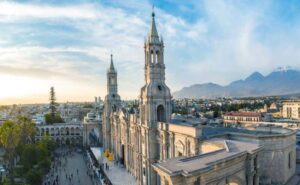Peru, a captivating South American gem, is a treasure trove of cultural richness, historical marvels, and breathtaking landscapes. From the mystical ruins of Machu Picchu to the vibrant city life of Lima, this country offers an array of experiences that cater to every traveler’s taste. Let’s embark on a virtual journey through the top 15 tourist attractions that make Peru an irresistible destination.
1. Machu Picchu: A Marvel in the Clouds
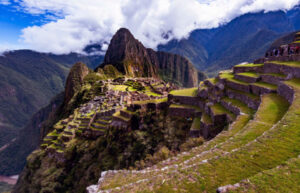
Perched atop the Andes Mountains, Machu Picchu is an architectural marvel and a testament to the ingenuity of the ancient Incan civilization. The journey to Machu Picchu is an adventure in itself, with travelers often opting for the classic Inca Trail or the more recent alternative treks. As you ascend through lush cloud forests and winding mountain trails, the anticipation builds, leading to the breathtaking moment when the iconic Sun Gate reveals Machu Picchu in all its splendor.
The site itself is a mesmerizing blend of meticulously crafted stone structures, including temples, terraces, and plazas, all surrounded by the majestic peaks of the Andes. The skilled engineering of the Incas is evident in the precision of the stone masonry, with each piece fitting seamlessly into place without the use of mortar. Exploring the Temple of the Sun, the Intihuatana stone, and the agricultural terraces provides insight into the spiritual, astronomical, and agricultural practices of the Inca people.
Beyond the archaeological significance, Machu Picchu offers awe-inspiring panoramic views of the surrounding mountains and the Urubamba River below. The site’s strategic location, perched on a mountain ridge, adds to its mystique and highlights the harmony between human-made structures and the natural environment. As visitors traverse the stone pathways and marvel at the well-preserved ruins, a profound connection to the ancient past is forged, making Machu Picchu a once-in-a-lifetime experience.
In addition to the classic trekking routes, alternative access options such as the scenic train ride from Cusco to Aguas Calientes provide a different perspective of the Andean landscape. Whether reached by foot or rail, Machu Picchu stands as a testament to the enduring legacy of the Inca civilization, inviting modern-day adventurers to unravel its mysteries and immerse themselves in the enchanting atmosphere of this mountaintop citadel.
2. Cusco: The Historic Heartbeat
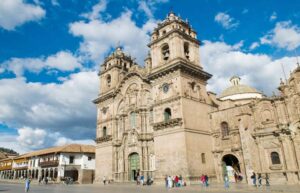
Cusco, often referred to as the historic heartbeat of Peru, is a city where every cobblestone street and colonial building tells a story of the past. The Plaza de Armas, the main square, serves as the pulsating center of Cusco’s historical charm. Surrounded by architectural wonders such as the Cathedral and the Church of the Society of Jesus, the plaza invites visitors to step back in time and soak in the blend of Incan and Spanish influences.
Strolling through the streets of Cusco is a journey through different epochs, with each building and alleyway contributing to the city’s rich tapestry. The Qorikancha, the Inca Temple of the Sun, provides a vivid contrast as the Spanish colonial architecture overlays the ancient Incan stone walls. The fusion of these two cultural epochs creates a unique atmosphere that captures the essence of Cusco.
Beyond the historical sites, Cusco’s markets burst with life and color, offering a sensory experience that engages visitors in the daily rhythm of the city. The San Pedro Market, in particular, showcases the vibrant tapestry of Andean culture through its array of fresh produce, traditional textiles, and local crafts. Engaging with the locals and sampling traditional dishes like alpaca skewers or quinoa soup adds a personal touch to the Cusco experience.
In the surrounding hills, archaeological sites such as Sacsayhuaman and Tambomachay provide further insight into the city’s ancient past. The massive stone walls of Sacsayhuaman, in particular, stand as a testament to the Inca’s remarkable engineering skills. Whether wandering through the historic streets, exploring ancient ruins, or indulging in local delicacies, Cusco offers a captivating blend of history, culture, and modern vibrancy that resonates with every visitor.
3. Lima: Culinary Delights and Coastal Wonders
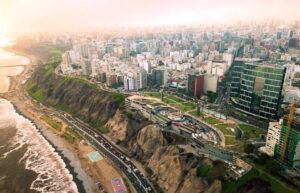
Lima, Peru’s coastal capital, beckons with a unique blend of culinary delights and coastal beauty. The city’s gastronomic scene has garnered international acclaim, earning Lima the title of “Gastronomic Capital of South America.” From traditional ceviche to innovative fusion dishes, Lima’s restaurants cater to a diverse range of tastes, making it a paradise for food enthusiasts.
Exploring Lima’s historic districts adds another layer to the city’s charm. Barranco, with its bohemian atmosphere and colorful houses, offers a perfect backdrop for leisurely strolls. The Puente de los Suspiros (Bridge of Sighs) and the vibrant art scene contribute to the district’s artistic allure. Meanwhile, Miraflores, situated along the picturesque Malecón boardwalk, provides stunning views of the Pacific Ocean. The Larcomar shopping center and Parque del Amor are popular spots where locals and visitors alike gather to enjoy the coastal breeze and breathtaking sunsets.
The culinary journey in Lima extends beyond restaurants, with local markets like Mercado Surquillo offering a glimpse into the diverse ingredients that contribute to Peru’s renowned cuisine. The market’s bustling atmosphere, coupled with the aromas of fresh produce and spices, creates an immersive experience for those eager to understand the foundations of Peruvian gastronomy.
For those seeking adventure, Lima’s coastal cliffs provide the perfect setting for paragliding, offering a unique perspective of the city and the vast expanse of the Pacific Ocean. The nearby Palomino Islands, home to sea lions and various seabird species, offer a memorable boat tour experience. Lima’s ability to seamlessly blend culinary excellence with coastal wonders makes it a destination that satisfies both the palate and the sense of exploration. Whether savoring ceviche by the sea, exploring historic districts, or embarking on coastal adventures, Lima stands as a dynamic gateway to Peru’s diverse offerings.
4. Lake Titicaca: A Tranquil Oasis
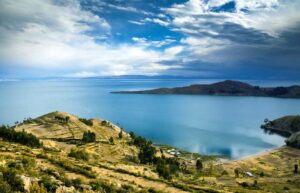
Lake Titicaca, nestled between the Andean mountain ranges of Peru and Bolivia, is a tranquil oasis of breathtaking beauty and cultural significance. The journey to Lake Titicaca is often marked by scenic drives through the high-altitude landscapes, revealing snow-capped peaks and traditional Andean villages. Arriving at the shores of the lake, visitors are greeted by a sense of serenity that permeates the air.
The floating islands of Uros, crafted from totora reeds, offer a unique glimpse into the traditional lifestyle of the indigenous Uru people. These man-made islands, floating on the lake’s surface, create a surreal experience as visitors walk on the springy surface of the reeds. Engaging with the local communities provides insights into their customs, craftsmanship, and a way of life that has endured for centuries.
A boat ride on Lake Titicaca unveils its vast expanse and the surrounding landscapes, with the Andean peaks reflecting on the clear blue waters. The tranquility of the lake, coupled with the distant sound of lapping waves, creates a sense of peaceful escape. The islands of Taquile and Amantani, known for their indigenous communities and ancient agricultural terraces, offer immersive cultural experiences for those seeking a deeper connection with the region.
The unique combination of natural beauty and cultural richness makes Lake Titicaca a destination where travelers can unwind and appreciate the simplicity of life at a slower pace. Whether navigating the floating islands, exploring the traditional villages, or simply enjoying the serene landscapes, Lake Titicaca provides a tranquil oasis that captivates the hearts of those who venture to its shores.
5. Arequipa: The White City
Arequipa, often referred to as the White City due to the distinctive white volcanic stone used in its architecture, invites visitors to explore its colonial charm and captivating landscapes. The city’s historical center, a UNESCO World Heritage Site, boasts well-preserved colonial buildings, including the stunning Basilica Cathedral and the Compañía de Jesús Church. The Monastery of Santa Catalina, a city within a city, provides a fascinating glimpse into the lives of nuns during the colonial era.
The backdrop of Arequipa is dominated by the majestic Misti Volcano, adding a dramatic touch to the city’s skyline. The surrounding countryside, with its terraced fields and traditional villages, offers opportunities for day trips to delve into the agricultural and cultural richness of the region. Exploring the Yanahuara district, known for its iconic viewpoint offering panoramic views of Arequipa and the volcanoes, provides a perfect introduction to the city’s picturesque setting.
Arequipa’s culinary scene is a delightful fusion of traditional Peruvian flavors and international influences. Local markets, such as the San Camilo Market, showcase a vibrant array of Andean produce and culinary delights. Sampling regional dishes like rocoto relleno and alpaca steak adds a savory dimension to the overall Arequipa experience.
As day turns to night, the city comes alive with a lively atmosphere. The Plaza de Armas, illuminated by the warm glow of streetlights, becomes a social hub where locals and visitors gather. Arequipa’s vibrant nightlife, with its mix of traditional peñas and modern bars, provides options for every taste.
In essence, Arequipa’s allure lies in its ability to seamlessly blend colonial history with natural beauty, creating a city that appeals to history enthusiasts, nature lovers, and culinary adventurers alike. Whether exploring the architectural gems of the historic center, marveling at the Misti Volcano, or savoring the local cuisine, Arequipa stands as a testament to the harmonious coexistence of cultural heritage and natural wonders.
6. Nazca Lines: A Mysterious Enigma
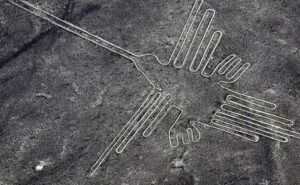
The Nazca Lines, etched into the arid Nazca Desert, stand as an enigmatic testament to the creativity and precision of ancient civilizations. Spanning an expansive area, these massive geoglyphs depict various animals, geometric shapes, and humanoid figures, visible only from the air. The mystery surrounding their purpose and the sheer scale of their creation continue to captivate researchers and visitors alike.
Taking a flight over the Nazca Lines provides a surreal and awe-inspiring experience. As the small aircraft soars over the desert, the intricate patterns below come to life, revealing the immense effort and meticulous planning involved in their construction. The hummingbird, spider, and monkey figures, among others, showcase the Nazca people’s deep connection to their surroundings and a sophisticated understanding of geometric proportions.
Theories abound regarding the purpose of the Nazca Lines, ranging from astronomical calendars to religious ceremonies. The alignment of the geoglyphs with celestial events adds another layer to the complexity of their creation. Despite decades of study, the Nazca Lines continue to be shrouded in mystery, inviting speculation and sparking the imagination of those who gaze upon them.
The Nazca Lines are not only a testament to the ancient Nazca civilization’s engineering prowess but also a reminder of the intricate relationship between human societies and the natural world. The preservation of these geoglyphs, despite the harsh desert conditions, underscores the significance the Nazca people attributed to their creation.
Visitors to the Nazca Lines not only witness a marvel of ancient artistry but also become part of an ongoing dialogue between the past and the present. The sense of wonder and curiosity evoked by these colossal figures makes a journey to the Nazca Desert an essential pilgrimage for those seeking to unravel the mysteries of our shared human history.
7. Amazon Rainforest: Nature’s Symphony
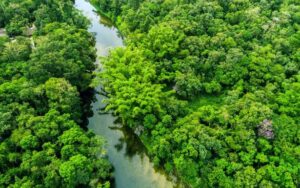
The Amazon Rainforest, often referred to as the “lungs of the Earth,” unfolds as a vast, green symphony of biodiversity and natural wonders in Peru. Exploring this ecological marvel offers a sensory journey into the heart of one of the planet’s most diverse ecosystems. Guided tours into the Amazon provide not just a glimpse but a full immersion into the lush greenery, diverse wildlife, and the captivating sounds that define this unparalleled natural habitat.
The Amazon Basin in Peru is home to a staggering variety of plant and animal species, many of which are found nowhere else on Earth. As you venture deeper into the rainforest, the air becomes thick with the scents of exotic flora, and the sounds of tropical birds, insects, and distant river currents create a harmonious cacophony. It’s a symphony that encompasses the entire spectrum of the natural world, from the vibrant calls of howler monkeys to the melodic chirping of colorful birds.
Guides, often indigenous to the region, share their deep knowledge of the rainforest’s flora and fauna, offering insights into the delicate balance that sustains this intricate ecosystem. The medicinal plants used by local communities for generations, the hidden creatures that camouflage seamlessly with their surroundings, and the interconnectedness of the Amazon’s web of life become tangible aspects of the journey.
River excursions along the Amazon provide an opportunity to witness the convergence of water and land ecosystems. Pink dolphins playfully surf the river currents, and caimans bask along the muddy banks. The water itself is teeming with life, from piranhas to electric eels, offering a fascinating perspective on the biodiversity that flourishes both above and below the surface.
Engaging in a night walk through the Amazon unveils a different realm of activity. Nocturnal creatures, from tree frogs to elusive big cats, come to life in the darkness. The sounds of the rainforest take on a mysterious quality, heightening the sense of adventure and discovery.
While the Amazon Rainforest is a sanctuary for nature enthusiasts, it also serves as a crucial player in the global ecosystem. Recognizing the delicate balance and interconnectedness of life within this vast expanse is not just a journey of exploration but an acknowledgment of the vital role the Amazon plays in sustaining life on Earth. Each rustle of leaves, each exotic call of a bird, and each breathtaking moment in the Amazon Rainforest becomes a chapter in a symphony that resonates with the beauty and fragility of our planet.
8. Colca Canyon: Majestic Vistas
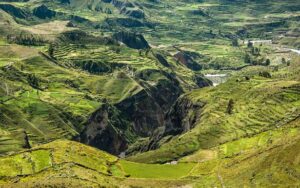
Colca Canyon, carved by the Colca River, stands as one of the world’s deepest canyons, offering majestic vistas and unparalleled opportunities for exploration. Located in the highlands of Peru, the journey to Colca Canyon takes travelers through picturesque Andean landscapes, dotted with traditional villages and terraced fields.
As visitors approach the canyon, the sheer magnitude of its depth becomes apparent. The vast expanse of the canyon reveals itself, with rugged cliffs and deep ravines stretching as far as the eye can see. The Cruz del Condor viewpoint, perched on the canyon’s edge, provides an awe-inspiring vantage point for observing the majestic Andean condors soaring on the thermals that rise from the canyon floor.
Hiking trails along the canyon rim offer both novice and experienced trekkers the opportunity to immerse themselves in the breathtaking scenery. The Colca Canyon trek is a journey through changing landscapes, from high-altitude plains to lush agricultural terraces, providing a glimpse into the agricultural traditions of the indigenous communities that call this region home.
Beyond the natural beauty, Colca Canyon is home to traditional villages, including Chivay and Yanque, where visitors can engage with local communities and witness daily life in the highlands. The thermal baths in Chivay provide a relaxing respite, allowing travelers to unwind and enjoy the therapeutic properties of the natural hot springs against the backdrop of the canyon.
For those seeking a more adventurous experience, white-water rafting in the Colca River offers an exhilarating descent through the canyon’s rapids. The juxtaposition of adrenaline-pumping activities against the serene backdrop of the canyon creates a well-rounded experience for thrill-seekers and nature enthusiasts alike.
Colca Canyon is not merely a geological marvel; it’s a living testament to the Andean way of life and the resilience of communities in challenging environments. The agricultural terraces, known as “andenerías,” showcase ancient farming techniques that have sustained local populations for centuries. As travelers descend into the canyon and explore its nooks and crannies, they become part of a narrative that transcends time, connecting the present with the enduring traditions of the past.
Whether gazing at condors in flight, hiking along canyon trails, or interacting with locals in traditional villages, Colca Canyon offers a symphony of experiences that celebrate the grandeur of nature and the cultural richness of the Andean highlands.
9. Huacachina: Oasis in the Desert
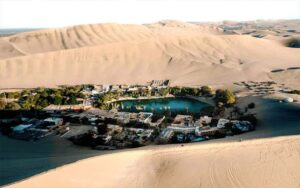
Huacachina, a tiny oasis nestled among towering sand dunes in the Ica Desert, presents a stark contrast to Peru’s historical and cultural attractions. This desert haven offers a unique blend of adrenaline-fueled adventure and serene relaxation. The journey to Huacachina involves traversing arid landscapes that gradually give way to the lush palm-fringed lagoon at the heart of the oasis.
The oasis itself is surrounded by colossal sand dunes, providing a surreal setting for activities that cater to both thrill-seekers and those seeking a more tranquil escape. Sandboarding, an exhilarating sport that involves descending the dunes on a sandboard, draws adventurers from around the world. Dune buggies, with their expert drivers, navigate the steep slopes, creating a rollercoaster-like experience that adds an adrenaline rush to the desert adventure.
As the sun sets over the desert, the hues of the sand dunes transform, creating a breathtaking panorama. Dusk marks the beginning of a unique experience known as “sand skiing” or “sand sledding,” where visitors can glide down the dunes on sleds, creating memories against the backdrop of the setting sun. The changing colors of the desert landscape during this magical hour add a touch of romance to the oasis experience.
Huacachina’s lagoon, surrounded by palm trees and the occasional desert bird, provides a peaceful retreat for those seeking relaxation. The calm waters mirror the surrounding dunes, creating a tranquil environment for boat rides or simply basking in the oasis’s natural beauty. Sunset boat tours offer a different perspective, allowing visitors to witness the sun dipping below the dunes and casting a warm glow over the oasis.
The small village of Huacachina, with its unique charm and laid-back atmosphere, invites travelers to explore its vibrant culture. Local markets showcase traditional crafts, and the quaint streets are dotted with bars and restaurants offering a taste of Peruvian hospitality. The oasis’s intimate size fosters a sense of community, making it easy for visitors to engage with locals and share in the oasis’s enchanting ambiance.
Huacachina’s juxtaposition of adventure and tranquility, set against the backdrop of towering sand dunes and a pristine lagoon, creates a destination that caters to diverse tastes. Whether seeking the thrill of sandboarding, the serenity of a desert sunset, or the warmth of a close-knit community, Huacachina stands as a unique oasis that defies expectations and leaves an indelible mark on the hearts of those who venture into its sandy embrace.
10. Paracas National Reserve: Coastal Marvels
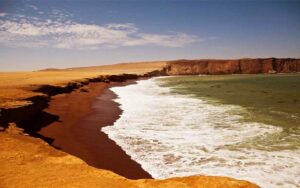
The Paracas National Reserve, a coastal wonderland on the southern coast of Peru, captivates visitors with its stark beauty, diverse wildlife, and dramatic landscapes. The reserve, encompassing both land and sea, offers a unique blend of desert and marine ecosystems, creating a haven for nature enthusiasts and those seeking a peaceful escape by the ocean.
One of the highlights of the Paracas National Reserve is the Ballestas Islands, often referred to as the “Poor Man’s Galapagos.” These rocky islands are home to an incredible array of marine life, including sea lions, penguins, and various seabird species. Boat tours around the Ballestas Islands provide a close-up view of these animals in their natural habitat, creating a memorable experience for wildlife enthusiasts and photographers.
The red sand beaches that line the reserve’s coastline add a striking contrast to the deep blue waters of the Pacific Ocean. The cliffs and rock formations, sculpted by wind and waves, create a rugged and otherworldly landscape. Playa Roja, one of the reserve’s iconic beaches, owes its distinctive red hue to the presence of iron-rich minerals, offering a unique backdrop for sunsets and leisurely strolls along the shore.
The Paracas Peninsula, extending into the Pacific, is home to archaeological sites that provide insights into the region’s ancient cultures. The Candelabro, a mysterious and massive geoglyph etched into the sandy slopes of the peninsula, adds an air of intrigue to the reserve. The purpose and origin of this enigmatic figure, resembling a candelabrum, continue to be a subject of speculation and fascination.
The Paracas National Reserve is also a haven for birdwatchers, with numerous species of coastal and migratory birds frequenting the area. The reserve’s diverse ecosystems support a rich variety of flora, adapted to thrive in the arid desert conditions. The sheer abundance of life, both on land and at sea, underscores the importance of preserving this coastal marvel for future generations.
For those seeking outdoor adventures, the Paracas National Reserve offers opportunities for activities such as kayaking and sandboarding, allowing visitors to engage with the natural environment in an active and immersive way. The reserve’s commitment to conservation and sustainable tourism ensures that the delicate balance between human activity and the fragile ecosystems remains intact.
In essence, the Paracas National Reserve stands as a testament to the beauty and resilience of Peru’s coastal landscapes. From the vibrant marine life of the Ballestas Islands to the surreal red beaches and dramatic cliffs, every corner of the reserve tells a story of the enduring connection between land and sea. Whether exploring the archaeological mysteries or simply enjoying the tranquility of the coastline, the Paracas National Reserve invites travelers to embrace the wonders of the Peruvian coast.
11. Chan Chan: Ancient Adobe City
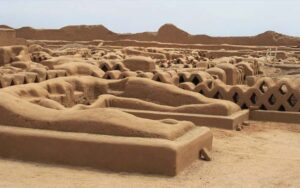
Chan Chan, the largest pre-Columbian city in South America, unfolds as an archaeological marvel on the northern coast of Peru. This ancient adobe city, built by the Chimu civilization, showcases the intricate craftsmanship and urban planning of a civilization that thrived in the arid coastal region. The sprawling city, designated as a UNESCO World Heritage Site, invites visitors to step back in time and explore its well-preserved remnants.
The heart of Chan Chan is the Tschudi Complex, a vast series of adobe-walled enclosures that once served as administrative and ceremonial centers. The walls are adorned with intricate reliefs, depicting stylized figures, animals, and mythological scenes. The precision of the adobe brickwork, combined with the artistic detailing, highlights the architectural achievements of the Chimu people and their dedication to creating a city that reflected their cultural identity.
One of the notable features of Chan Chan is the absence of monumental stone architecture, a stark contrast to other ancient civilizations in the Americas. The use of adobe, a material made from sun-dried mud bricks, showcases the Chimu’s adaptability to the coastal environment and their innovative construction techniques. The labyrinthine layout of the city, with its maze-like walls and courtyards, adds a sense of mystery to the exploration.
The Nik-An Palace, within the Tschudi Complex, stands out as a testament to the city’s social hierarchy. Elaborate friezes and ornate courtyards provide glimpses into the lives of the ruling elite, emphasizing the stratified nature of Chimu society. As visitors navigate the passageways and chambers, they gain insights into the complex organizational structure and cultural practices that defined life in Chan Chan.
Despite its historical significance, Chan Chan faces ongoing challenges due to environmental factors, including erosion and climatic changes. Preservation efforts are underway to safeguard this archaeological treasure and ensure that future generations can continue to marvel at the ingenuity of the Chimu civilization.
Exploring Chan Chan is a journey into the complexities of ancient urban life along Peru’s coast. The city’s proximity to the Pacific Ocean, with its reliance on fishing and marine resources, influenced both its economy and cultural practices. The interconnectedness between the city and its environment is evident in the depictions of marine life on the adobe walls and the strategic placement of ceremonial spaces.
Chan Chan’s archaeological significance extends beyond its physical structures. The ongoing research and excavation efforts contribute to a deeper understanding of the Chimu civilization and its interactions with neighboring cultures. As the mysteries of Chan Chan continue to unfold, visitors partake in a shared exploration of an ancient city that thrived in harmony with its coastal surroundings, leaving an indelible mark on Peru’s archaeological landscape.
12. Kuelap: Fortress in the Clouds
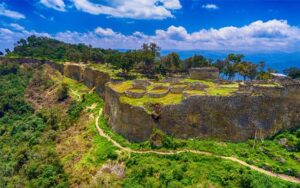
Kuelap, perched on a mountaintop in the northern Andes, is a fortress that predates Machu Picchu and offers a glimpse into the fascinating history of the Chachapoya culture. Often referred to as the “Machu Picchu of the North,” Kuelap stands as a testament to the strategic prowess and architectural ingenuity of an ancient civilization that flourished in the cloud forest.
The approach to Kuelap involves a scenic journey through lush landscapes and cloud-kissed peaks. As visitors ascend to the fortress, the dense vegetation opens up to reveal the towering walls of Kuelap, creating a sense of anticipation for the historical treasures hidden within. The fortress, situated at an altitude of nearly 10,000 feet, commands panoramic views of the surrounding valleys and mountains.
The outer walls of Kuelap, reaching heights of up to 60 feet, are constructed with massive limestone blocks. The precision of the stone masonry and the strategic positioning of watchtowers showcase the defensive capabilities of the fortress. The circular structures within Kuelap, known as chullpas, served as homes for the Chachapoya elite, and their unique design reflects the cultural identity of this ancient civilization.
The entrance to Kuelap is marked by a narrow passageway, known as the “Malca,” flanked by towering walls on either side. The intricate carvings on the stone blocks depict zoomorphic figures and geometric patterns, providing a glimpse into the artistic sophistication of the Chachapoya people. As visitors pass through the entrance, they enter a ceremonial plaza surrounded by structures that once housed the religious and administrative functions of Kuelap.
The Chachapoya culture, often referred to as the “Warriors of the Clouds,” left behind a legacy of architectural marvels that are still being uncovered. Recent archaeological discoveries within Kuelap, including burial sites and ritualistic artifacts, contribute to a deeper understanding of the spiritual and cultural practices of this ancient civilization.
The cloud forest that envelops Kuelap adds a mystical quality to the fortress, shrouding it in mist and creating an ethereal atmosphere. The biodiversity of the region, with its endemic plant and animal species, enhances the experience of exploring this historical site. Orchids, bromeliads, and moss-covered trees create a vibrant tapestry, providing a stark contrast to the stone structures that have withstood the test of time.
Kuelap, with its unique architectural features and historical significance, offers a journey into the heart of the Chachapoya culture. The fortress stands as a testament to the adaptability of ancient civilizations to their natural environments, creating structures that harmonize with the cloud forest while asserting their strategic dominance. As visitors traverse the pathways and plazas of Kuelap, they embark on a pilgrimage through history, unraveling the mysteries of a civilization that thrived amidst the clouds.
13. Huaraz: Gateway to the Andes
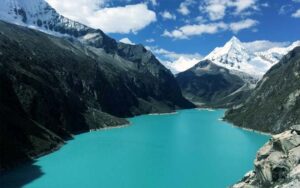
Huaraz, nestled in the Callejón de Huaylas valley, serves as the ideal gateway for those seeking Andean adventures and high-altitude exploration. Surrounded by snow-capped peaks, including the stunning Huascaran, Peru’s highest mountain, Huaraz offers a plethora of trekking opportunities, cultural experiences, and breathtaking vistas that capture the essence of the Andes.
The city itself, with its charming squares and colonial architecture, provides a comfortable base for acclimatization before venturing into the higher altitudes of the Cordillera Blanca and Cordillera Huayhuash. The Plaza de Armas, adorned with gardens and overlooked by the neoclassical Cathedral, offers a serene setting for visitors to soak in the mountainous ambiance.
Trekking in Huaraz unveils a world of natural wonders, from turquoise glacial lakes to towering mountain passes. The Santa Cruz Trek, a popular choice for trekkers, takes you through pristine landscapes, passing by alpine meadows, ancient Quenual forests, and beneath the shadows of towering peaks. The reward at the trek’s apex is the breathtaking view of the majestic Alpamayo, often hailed as one of the world’s most beautiful mountains.
For those seeking a more challenging trek, the Huayhuash Circuit offers a multi-day journey through some of the most remote and spectacular landscapes in the Andes. Towering peaks, high-altitude lakes, and encounters with traditional Quechua-speaking communities make this trek an immersive experience in both natural beauty and cultural exchange.
Huaraz is not only a haven for trekkers but also a cultural hub that showcases the traditions of the Andean communities. The Wilcahuain Archaeological Site, with its ancient circular stone structures, provides a glimpse into pre-Inca cultures that once thrived in the region. The nearby Chavin de Huantar, a UNESCO World Heritage Site, is an archaeological complex that dates back to 1200 BCE, showcasing advanced engineering and religious significance.
The vibrant markets of Huaraz, such as the Mercado de los Productores, allow visitors to engage with local communities and sample traditional Andean cuisine. The warmth of the people, coupled with the colorful textiles and handicrafts, adds a personal touch to the cultural exploration of Huaraz.
Beyond trekking and cultural experiences, Huaraz offers adrenaline-pumping activities for adventure enthusiasts. Mountain biking down the rugged trails, rock climbing in the Cordillera Blanca, and paragliding over the breathtaking landscapes are just a few of the options available for those seeking an extra dose of excitement.
Huaraz, with its strategic location and unparalleled access to the Andean wonders, stands as a testament to the adventurous spirit that beckons travelers to explore the heights of Peru. Whether summiting mountain peaks, delving into ancient cultures, or simply savoring the tranquility of the Andean landscapes, Huaraz serves as the perfect starting point for an exploration of the natural and cultural treasures that define the heart of the Andes.
14. Puno and Lake Titicaca’s Floating Islands: A Cultural Odyssey
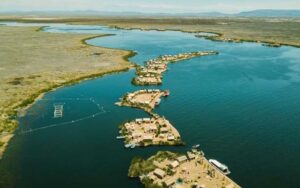
Puno, located on the shores of Lake Titicaca, provides a gateway to the unique cultural heritage of the Andean communities and the enchanting world of the Uros Floating Islands. The city’s vibrant markets, traditional festivals, and proximity to the highest navigable lake in the world make Puno a captivating destination that celebrates the rich tapestry of Andean life.
The indigenous Aymara and Quechua cultures converge in Puno, creating a melting pot of traditions that come to life in the city’s streets and squares. The Candelaria Festival, held in February, is a spectacular showcase of colorful costumes, traditional dances, and lively music that reverberates through the city. Visitors during this time are treated to a visual and auditory feast that highlights the resilience and pride of the Andean communities.
Lake Titicaca, with its deep blue waters and surrounding mountains, provides a serene backdrop for exploration. Boat excursions from Puno take visitors to the Uros Floating Islands, a marvel of ancient engineering and resourcefulness. Crafted from totora reeds, these man-made islands rise from the lake’s surface, creating a surreal environment that seems to float amidst the vast expanse of water.
Engaging with the Uros communities on the floating islands offers insights into their traditional way of life. The locals, known for their craftsmanship in weaving and boat-making, share stories of resilience and adaptation to the ever-changing lake environment. Visitors can participate in demonstrations of traditional activities, such as weaving intricate reed crafts or navigating the reed boats that serve as a primary mode of transportation.
A short boat ride from the Uros Islands leads to Taquile, one of Lake Titicaca’s natural islands with a rich cultural heritage. The indigenous Quechua-speaking inhabitants of Taquile are known for their textile expertise, producing vibrant textiles that depict the island’s history and traditions. A stroll through the island’s terraced fields and visits to local artisan workshops provide a deeper understanding of the interconnectedness between the people and their environment.
Back in Puno, the bustling markets, such as the Mercado Central, offer an opportunity to immerse oneself in the local flavors and craftsmanship of the region. Traditional dishes like the hearty quinoa soup and the indigenous favorite, cuy (guinea pig), provide a taste of the culinary richness that defines Andean cuisine.
Puno’s role as a cultural crossroads and its proximity to Lake Titicaca’s unique islands make it a destination where travelers can embark on a cultural odyssey. Whether witnessing the exuberance of the Candelaria Festival, navigating the floating reed islands, or exploring the artisan traditions of Taquile, Puno invites visitors to delve into the living heritage of the Andean highlands.
15. Trujillo: Colonial Elegance and Archaeological Wonders
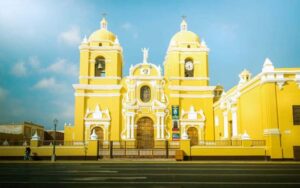
Trujillo, on the northern coast of Peru, captivates visitors with its colonial charm, elegant mansions, and proximity to the archaeological wonders of the Moche and Chimu civilizations. This city, steeped in history, serves as a gateway to ancient pyramids, adobe temples, and a vibrant cultural scene that reflects the diverse influences that have shaped the region.
The city’s historic center, adorned with colonial architecture and colorful facades, invites leisurely strolls through its cobblestone streets. The Plaza de Armas, surrounded by neoclassical buildings and palm trees, creates a picturesque setting for locals and visitors alike. The Trujillo Cathedral and the Archbishop’s Palace showcase the colonial elegance that defines the city’s architectural heritage.
One of the notable attractions near Trujillo is the Chan Chan Archaeological Site, the largest adobe city in the ancient world. Built by the Chimu civilization, Chan Chan encompasses a vast complex of palaces, plazas, and intricate murals. Exploring the Tschudi Palace within Chan Chan provides a glimpse into the ceremonial and administrative functions of this ancient city, showcasing the Chimu people’s mastery of adobe construction.
The nearby Huaca de la Luna and Huaca del Sol, remnants of the Moche civilization, offer a journey back in time to a society that thrived in the desert landscape. The colorful murals and intricate reliefs at Huaca de la Luna depict the Moche’s cosmology, rituals, and deities. Archaeological excavations continue to unveil new discoveries, adding layers to the understanding of the Moche culture.
Trujillo’s coastal location also provides access to the beachside resort of Huanchaco, known for its iconic reed boats called “caballitos de totora.” These traditional watercraft, crafted from totora reeds, have been used by local fishermen for centuries and are an integral part of Huanchaco’s cultural identity. Visitors can witness the skillful maneuvering of these unique boats and even try their hand at riding the waves on them.
For those seeking a more immersive cultural experience, the Marinera, a traditional Peruvian dance, takes center stage during Trujillo’s National Marinera Festival. The graceful movements, vibrant costumes, and rhythmic beats of the Marinera showcase the region’s Afro-Peruvian and Spanish influences, creating a dynamic celebration of cultural diversity.
Trujillo’s culinary scene adds another layer to the city’s allure, with local markets offering a variety of traditional dishes. The ceviche, made with fresh seafood and Peruvian limeño chili, is a coastal delicacy that delights the taste buds. Traditional sweets like King Kong, a dessert filled with manjar blanco and nuts, provide a sweet conclusion to a culinary journey through Trujillo.
In essence, Trujillo stands as a multifaceted destination that seamlessly blends colonial elegance with archaeological marvels and vibrant cultural traditions. Whether exploring the adobe city of Chan Chan, marveling at the Moche temples, or indulging in the flavors of Peruvian cuisine, visitors to Trujillo embark on a journey through time and cultural richness, discovering the layers of history that define this enchanting city.
Conclusion
In conclusion, Peru unfolds as a tapestry of diverse landscapes, ancient civilizations, and vibrant cultures that beckon travelers to explore its treasures. From the iconic Machu Picchu to the enigmatic Nazca Lines, the tranquil Lake Titicaca to the archaeological wonders of Chan Chan, each destination offers a unique chapter in Peru’s rich narrative.
Whether trekking through the Andean highlands, immersing in the cultural festivities of Puno, or navigating the floating islands of Lake Titicaca, visitors find themselves embraced by the warmth of Peruvian hospitality. The culinary delights, archaeological marvels, and natural wonders create a symphony of experiences that resonate with the heart and soul of this South American gem.
Peru’s ability to balance tradition and modernity, history and adventure, elevates it to a must-visit destination for those seeking a transformative journey. As travelers traverse the ancient trails, explore the diverse ecosystems, and engage with the vibrant communities, they become part of a narrative that transcends time, leaving them with indelible memories of a land where every step tells a story.
FAQs (Frequently Asked Questions)
Is Machu Picchu the only ancient site worth visiting in Peru?
- While Machu Picchu is undoubtedly a highlight, Peru boasts numerous other ancient sites like Chan Chan, Kuelap, and the Nazca Lines, each with its own unique historical significance.
What is the best time to visit Lake Titicaca for a peaceful experience?
- The months of May to September are considered ideal, offering dry weather and calm waters, creating a serene environment for exploring the lake and its surroundings.
Are the Nazca Lines visible from the ground?
- The Nazca Lines are best viewed from the air, and several companies offer flights over the desert to provide a comprehensive and awe-inspiring perspective.
Can I experience both adventure and relaxation in Huacachina?
- Absolutely! Huacachina offers thrilling activities like sandboarding and dune buggies for adventure seekers, while the oasis itself provides a tranquil setting for relaxation.
What makes Colca Canyon unique compared to other canyons?
- Colca Canyon’s depth, scenic landscapes, and the opportunity to witness Andean condors soaring make it a distinctive canyon experience.
These frequently asked questions aim to provide additional insights for travelers planning their journey to Peru, offering practical information and enhancing their overall experience in this captivating South American destination.
Next Article :- Costa Rica
